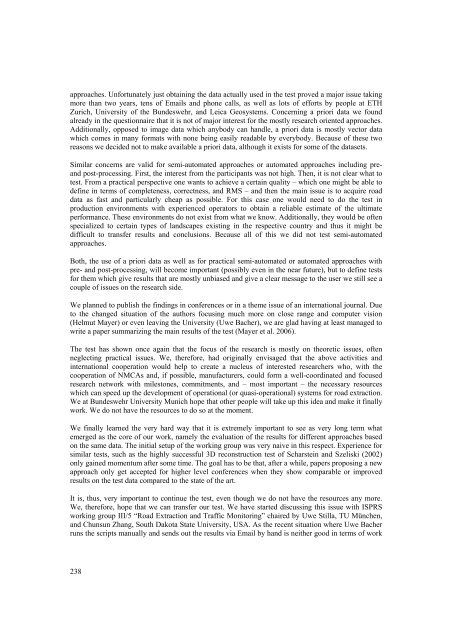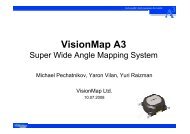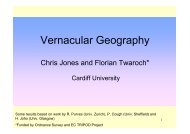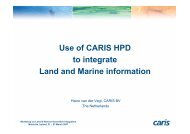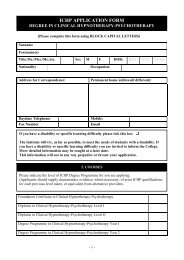EuroSDR Projects - Host Ireland
EuroSDR Projects - Host Ireland
EuroSDR Projects - Host Ireland
Create successful ePaper yourself
Turn your PDF publications into a flip-book with our unique Google optimized e-Paper software.
approaches. Unfortunately just obtaining the data actually used in the test proved a major issue taking<br />
more than two years, tens of Emails and phone calls, as well as lots of efforts by people at ETH<br />
Zurich, University of the Bundeswehr, and Leica Geosystems. Concerning a priori data we found<br />
already in the questionnaire that it is not of major interest for the mostly research oriented approaches.<br />
Additionally, opposed to image data which anybody can handle, a priori data is mostly vector data<br />
which comes in many formats with none being easily readable by everybody. Because of these two<br />
reasons we decided not to make available a priori data, although it exists for some of the datasets.<br />
Similar concerns are valid for semi-automated approaches or automated approaches including pre-<br />
and post-processing. First, the interest from the participants was not high. Then, it is not clear what to<br />
test. From a practical perspective one wants to achieve a certain quality – which one might be able to<br />
define in terms of completeness, correctness, and RMS – and then the main issue is to acquire road<br />
data as fast and particularly cheap as possible. For this case one would need to do the test in<br />
production environments with experienced operators to obtain a reliable estimate of the ultimate<br />
performance. These environments do not exist from what we know. Additionally, they would be often<br />
specialized to certain types of landscapes existing in the respective country and thus it might be<br />
difficult to transfer results and conclusions. Because all of this we did not test semi-automated<br />
approaches.<br />
Both, the use of a priori data as well as for practical semi-automated or automated approaches with<br />
pre- and post-processing, will become important (possibly even in the near future), but to define tests<br />
for them which give results that are mostly unbiased and give a clear message to the user we still see a<br />
couple of issues on the research side.<br />
We planned to publish the findings in conferences or in a theme issue of an international journal. Due<br />
to the changed situation of the authors focusing much more on close range and computer vision<br />
(Helmut Mayer) or even leaving the University (Uwe Bacher), we are glad having at least managed to<br />
write a paper summarizing the main results of the test (Mayer et al. 2006).<br />
The test has shown once again that the focus of the research is mostly on theoretic issues, often<br />
neglecting practical issues. We, therefore, had originally envisaged that the above activities and<br />
international cooperation would help to create a nucleus of interested researchers who, with the<br />
cooperation of NMCAs and, if possible, manufacturers, could form a well-coordinated and focused<br />
research network with milestones, commitments, and – most important – the necessary resources<br />
which can speed up the development of operational (or quasi-operational) systems for road extraction.<br />
We at Bundeswehr University Munich hope that other people will take up this idea and make it finally<br />
work. We do not have the resources to do so at the moment.<br />
We finally learned the very hard way that it is extremely important to see as very long term what<br />
emerged as the core of our work, namely the evaluation of the results for different approaches based<br />
on the same data. The initial setup of the working group was very naive in this respect. Experience for<br />
similar tests, such as the highly successful 3D reconstruction test of Scharstein and Szeliski (2002)<br />
only gained momentum after some time. The goal has to be that, after a while, papers proposing a new<br />
approach only get accepted for higher level conferences when they show comparable or improved<br />
results on the test data compared to the state of the art.<br />
It is, thus, very important to continue the test, even though we do not have the resources any more.<br />
We, therefore, hope that we can transfer our test. We have started discussing this issue with ISPRS<br />
working group III/5 “Road Extraction and Traffic Monitoring” chaired by Uwe Stilla, TU München,<br />
and Chunsun Zhang, South Dakota State University, USA. As the recent situation where Uwe Bacher<br />
runs the scripts manually and sends out the results via Email by hand is neither good in terms of work<br />
238


